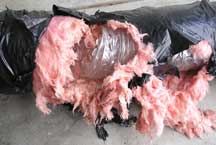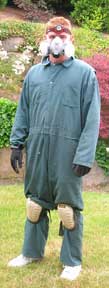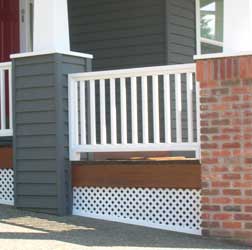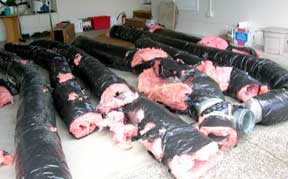 |
Previous Issues |
| Cedar Mill Community Website |
|
| Search the Cedar Mill News: | About Cedar Mill News |
|
|||||||
| Volume 7, Issue 9 | September 2009 |
||||||
|
 |
| An example of the damage to the Danner's heating ducts |
He told us that in the spring they find a place to prepare a nest to have their young. They stay in the nest until the kits can forage on their own—about three months. They keep their nest very clean, but establish a latrine near by—hence the stench. Raccoons tend to come back to the same nesting place year after year. Mr. Larsen set up two traps and over the next three weeks trapped two adults and seven kits. We saw one more adult who was upset over her kit in the trap, but she was never caught. (Raccoons are very smart and even learn how to get the bait out of the trap without triggering it.)
Once it was determined that there were no more raccoons in the crawl space, we then proceeded with Affordable Restoration and Remodel, a contractor who specializes in restoring crawlspaces. What we learned then was almost overwhelming. The raccoons had destroyed or seriously damaged all of the HVAC ducts, all of the under floor insulation, and the vapor barrier. Since we couldn’t see the damage ourselves, we decided we needed a second inspection and bid on repairs. Very few companies do this work, but we were able to get a second inspection and bid that confirmed the damage, but the bid was higher to repair it.
 The first task was to remove the latrines and then all the damaged material. The worker wore what looked like a haz-mat suit to do the work. They hauled away four huge trailers full of stuff. After removal, everything had to be sanitized and deodorized before putting in the new vapor barrier, ducts, and insulation. The repairs took almost a week, and were very expensive.
The first task was to remove the latrines and then all the damaged material. The worker wore what looked like a haz-mat suit to do the work. They hauled away four huge trailers full of stuff. After removal, everything had to be sanitized and deodorized before putting in the new vapor barrier, ducts, and insulation. The repairs took almost a week, and were very expensive.
In addition to repairs the contractor also secured all of the vents with heavy duty aluminum screens that are nailed into the concrete foundation and should be “raccoon proof.” Also, he replaced the lattice work around the front porch, installing it so that there are no openings or holes by which the raccoons can gain entrance to the space under the porch. This is very important since that one raccoon we didn’t trap may be back next spring!
Some of our neighbors, aware of our problem, had their vents inspected and reinforced with the heavy duty aluminum. They figured if the raccoons cannot get into our crawlspace next spring, they will be looking for a new nesting place nearby. We also sent an email about our experience to more neighbors and received back several replies about raccoons being seen in our area, which is north of Cornell Rd. between NW 95th Ave. and NW 100th Terrace.
 This experience surprised us since we had never seen any raccoons on our property in the six years we’ve lived here. The only thing we noticed a few times were animal footprints on the porch and railing. We just figured they were the prints of some animal “passing through.” We knew nothing about the habits of raccoons and never expected an animal could get under our house since all the vent screens were intact. Or so we mistakenly thought, not being aware of the vent under the porch.
This experience surprised us since we had never seen any raccoons on our property in the six years we’ve lived here. The only thing we noticed a few times were animal footprints on the porch and railing. We just figured they were the prints of some animal “passing through.” We knew nothing about the habits of raccoons and never expected an animal could get under our house since all the vent screens were intact. Or so we mistakenly thought, not being aware of the vent under the porch.
During this ordeal we Googled “raccoon” to learn more about them and their habits. There are many websites dealing with raccoons and wildlife in general. The Washington County website has helpful information at www.co.washington.or.us/HHS/AnimalServices/AnimalControl We also found helpful information at a Washington State website for the Washington Department of Fish and Wildlife. www.wdfw.wa.gov./wlm/living/raccoons.htm
Another surprise component to this experience was the level of stress we felt from the time of discovery until the repairs were completed. We worried about disease and the foul air we had been breathing. We wondered who could possibly clean up such a mess. We worried about recurrences, cost, etc. But we must tell you that the professionals we worked with at the pest control and repair companies were wonderful. They understood our stress and addressed all our worries. We are feeling whole again and hope that we have taken all the necessary measures to prevent a raccoon invasion next spring. If we haven’t, we know who to call.
Ed. Note: if you have raccoon trouble and are thinking of trying to relocate trapped animals, the Portland Audubon Society has this to say on their website (audubonportland.org/backyardwildlife/brochures/raccoons):
 |
| The raccoons destroyed or damaged all of their HVAC ducts |
Relocated raccoons are quickly replaced by other raccoons. The best solution is to leave the raccoons alone and remove or modify whatever is attracting them specifically to your yard.
Although many people perceive relocation as a humane approach to resolving conflicts, it is in fact just the opposite. Relocated raccoons have to fight with already established raccoons for territory, food and shelter. Many raccoons do not survive relocation and those that do disrupt already established populations. Relocated raccoon kits are almost always abandoned as it is near impossible for a mother to carry and care for her young while also establishing herself in a new territory.
Relocation of raccoons disrupts already established populations. Excessive “dumping” of raccoons into natural areas surrounding the Portland Metro area has resulted in ecological damage and been implicated in the transmission of disease among otherwise unaffected populations. Many local parks and natural areas now have policies prohibiting the dumping of raccoons.
Raccoons are protected under state law and relocation of these animals requires permits from the Oregon Department of Fish and Wildlife. If you hire a professional wildlife relocation service, be sure to ask to see their state permits prior to signing the contract.
Published monthly by Cedar Mill Advertising & Design
Publisher/Editor:Virginia Bruce
503-629-5799
PO Box 91061
Portland, Oregon 97291